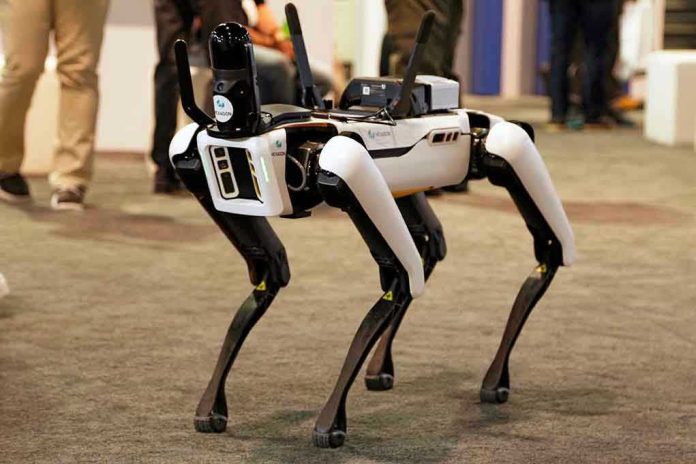
While American firefighters risk their lives daily, a Chinese-made $150,000 robo-dog is being hailed as the future of fire response—raising pressing questions about technological priorities, security, and the shifting role of humans in critical public safety jobs.
Story Snapshot
- The Unitree B2, a Chinese-developed robotic dog, is promoted as a firefighting breakthrough, but its adoption sparks debate over public safety, job security, and U.S. technological independence.
- B2’s advanced mobility, modular water cannon, and autonomous features are showcased as solutions for hazardous fires, with China leading real-world deployment.
- Experts praise its cost-effectiveness and technical prowess, but some warn these robots could displace workers or raise new vulnerabilities in emergency response.
- America’s first responders and policymakers face tough decisions on whether to embrace foreign-built robotics or double down on domestic innovation and traditional values.
China’s Robo-Dog: Firefighting Marvel or Trojan Horse?
The Unitree B2, a quadruped robot engineered by China’s Unitree Robotics, is making headlines for its recent upgrade: a powerful water/foam cannon and the ability to tackle fires in environments too dangerous for human responders. After drills with the Qingdao Firefighting and Rescue Support Team earlier this year, the B2 is now actively marketed as a game-changer in emergency response, capable of autonomously navigating hazardous zones and supporting first responders in urban and wildland scenarios. Its modular design, 60-meter cannon range, and self-cooling system underscore impressive technical progress. However, the fact that this innovation is spearheaded by a Chinese firm rather than American industry has drawn concern among those who value U.S. self-reliance and job security for firefighters.
Robotics in Emergency Response: Progress and Precedents
Quadruped robots have rapidly evolved, transitioning from research concepts like Boston Dynamics’ Spot to commercial platforms with practical applications in surveillance, inspection, and hazardous operations. Unitree Robotics has focused on making these high-performance machines more affordable and adaptable, pushing the frontier further with the firefighting B2. This robot can climb 15-inch obstacles, handle 45-degree stairs, and swap batteries mid-mission for extended use. Unlike earlier firefighting robots, which were typically limited by wheels or tracks, the B2’s legged mobility allows it to access complex and dangerous terrains—raising the bar for what’s possible in robot-assisted emergency services.
Firefighting remains among the most hazardous professions, with significant risks to life and limb. The B2’s development is a direct response to the need for reducing human exposure to these dangers. By automating certain high-risk tasks, such as direct fire suppression in structurally unsound areas, robotics promise a new level of operational safety. Yet, the rise of such technology leaves many American families wondering if automation will eventually sideline skilled firefighters, and if overreliance on foreign robotics could jeopardize national security or critical infrastructure.
Stakeholders, Security, and the U.S. Response
Key players in this technological shift include Unitree Robotics, the Qingdao Firefighting and Rescue Support Team, and fire departments worldwide considering adoption. While China has already fielded the B2 in drills and is leading in real-world deployment, American fire chiefs and municipal leaders are forced to weigh the benefits of cutting-edge robotic assistance against risks to jobs, privacy, and supply chain security. Municipal governments must also consider the high upfront cost of $150,000, balanced against potential savings in injury reduction and property protection. For those prioritizing U.S. constitutional values, the question is whether to trust vital emergency roles to foreign-manufactured machines or to invest in homegrown innovation that aligns with American principles of self-determination and workforce stability.
Industry analysts highlight the B2’s superior mobility and modularity compared to American competitors, noting features like autonomous hose detachment and self-cooling, which are absent in earlier models. Some experts tout the robot’s affordability and performance, while others caution that operational reliability and integration with human teams remain unproven, especially in unpredictable, large-scale emergencies. The absence of major contradictions in technical reporting underscores that the B2 is a legitimate leap forward—but it also means American policymakers and industry leaders must act decisively to avoid ceding leadership in critical technologies to geopolitical rivals.
Implications for American Values and the Path Forward
The arrival of the B2 robo-dog marks both an opportunity and a warning for the United States. In the short term, robotics like the B2 could enhance firefighter safety and efficiency, but long-term effects may include workforce displacement and increased reliance on foreign technology in essential services. Social trust in technology may grow, yet so too could concerns about privacy and security if public safety tools are sourced from adversarial nations. Ultimately, the B2’s rollout is a call to action for American innovators to reclaim leadership in emergency response technology, ensuring that future breakthroughs support—not undermine—our nation’s values, job security, and constitutional protections.
Sources:
Unitree B2 Firefighting Robot Joins the Battle Against Blazes (New Atlas, 2025)
Unitree Robotics B2 Official Product Page














